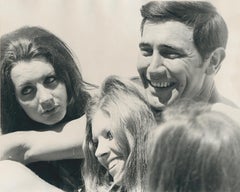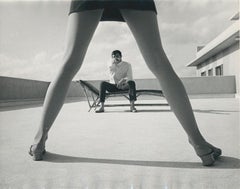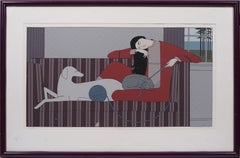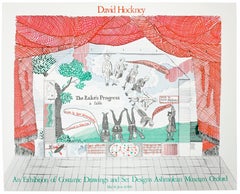Larry Ellis Interior Prints
to
2
Overall Width
to
Overall Height
to
2
9
106
79
38
30
2
2
2
2
2
1
1
1
1
1
1
1
2
Artist: Larry Ellis
George Lazenby in "James Bond 007 - On Her Majesty’s Secret Service", UK 1969
By Larry Ellis
Located in Cologne, DE
Guy Hamilton´s movie "James Bond 007 - Live and let die", UK 1973.
Actors: Roger Moore and Jane Saymour, George Lazenby
Keywords: James Bond, 007, act...
Category
1960s Modern Larry Ellis Interior Prints
Materials
Color
George Lazenby in "James Bond 007 - On Her Majesty’s Secret Service", UK 1969
By Larry Ellis
Located in Cologne, DE
Guy Hamilton´s movie "James Bond 007 - Live and let die", UK 1973.
Actors: Roger Moore and Jane Saymour, George Lazenby
Keywords: James Bond, 007, act...
Category
1960s Modern Larry Ellis Interior Prints
Materials
Color
Related Items
Antique American Modernist Portrait Signed Limited Edition Serigraph Interlude
By Will Barnet
Located in Buffalo, NY
Vintage American modernist interior scene by Will Barnet. Titled "Interlude". Signed and numbered limited edition from 1982.
Category
1980s Modern Larry Ellis Interior Prints
Materials
Screen
$1,580 Sale Price
20% Off
H 32 in W 49 in D 2 in
Vintage David Hockney Exhibition Poster Ashmolean Museum 1981
By David Hockney
Located in New York, NY
Poster produced for David Hockney’s 1981 exhibition at The Ashmolean Museum, Oxford, which displayed the sets and costumes he designed for the Glyndebourne Festival Opera’s 1975 prod...
Category
1980s Modern Larry Ellis Interior Prints
Materials
Offset
Les Musiciennes – lithograph, hand-signed and numbered
By Le Corbusier
Located in Zurich, CH
Together with "Bouteilles" one of the largest and most sought after lithographs by Le Corbusier, printed by Mourlot on Arches after a collage by LC....
Category
Mid-20th Century Modern Larry Ellis Interior Prints
Materials
Paper
$39,300
H 26.78 in W 38.59 in D 0.04 in
Inside the castle by David Hockney (Six Fairy Tales from the Brothers Grimm)
By David Hockney
Located in New York, NY
From David Hockney’s celebrated Six Fairy Tales from the Brothers Grimm portfolio, an image of the story ‘The boy who left home to learn fear’. Hockney chose this story for its obscu...
Category
1960s Modern Larry Ellis Interior Prints
Materials
Etching, Aquatint
$2,250
H 17.75 in W 16 in
Still Life with Goldfish
By Louis Comfort Tiffany
Located in Brooklyn, NY
This stunning exhibition poster was created for Louis Comfort Tiffany – Artist for the Ages, a show honoring the visionary craftsmanship of one of America’s most celebrated designers...
Category
Early 2000s American Modern Larry Ellis Interior Prints
Materials
Offset
"Labor in a Diesel Plant" Machine Age American Scene Industrial Mid 20th Century
By Letterio Calapai
Located in New York, NY
"Labor in a Diesel Plant" Machine Age American Scene Industrial Mid 20th Century
Letterio Calapai (American 1902-1993)
''Labor in A Diesel Plant''
Wood engraving, 1940
17 x 10 1/2...
Category
1940s American Modern Larry Ellis Interior Prints
Materials
Lithograph
$6,900
H 23 in W 16 in D 2 in
Ethel Katz, Fur Tailors, New Deal-era lithograph of sweatshop
Located in New York, NY
This is a classic New-Deal image: claustrophobic sweatshop with a row of hunched tailors. The windows and lamps offer light at least. But there is a major difference between this and...
Category
1930s American Modern Larry Ellis Interior Prints
Materials
Lithograph
$675
H 10.38 in W 15.5 in
"Balcony" 1938 WPA Print Mid 20th Century American Broadway Theatre Modernism
By Leon Bibel
Located in New York, NY
"Balcony" 1938 WPA Print Mid 20th Century American Broadway Theatre Modernism.
Silk screen on paper, 15” x 20". Numbered 15/20 lower left. Pencil si...
Category
1930s American Modern Larry Ellis Interior Prints
Materials
Paper, Screen
Adolf Dehn, The Big-Hearted Girls (The Last Veil), 1932, burlesque lithograph
By Adolf Dehn
Located in New York, NY
Adolf Dehn's, lithograph about burlesque, The Big Hearted Girls #2 (also known as The Last Veil), is filled with dancing girls and fabulous costumes. That central figure is a marvel!...
Category
1940s American Modern Larry Ellis Interior Prints
Materials
Lithograph
New Orleans Go Greyhound original vintage travel poster
Located in Spokane, WA
Orignal NEW ORLEANS GREYHOUND vintage travel poster; larger format size. Excellent condition that has acid-free archival linen backing; ready to frame.
This image is from the old French Quarter section of New Orleans. It features two women entering into the courtyard and in the background, the old stairs leading to the upstairs area. A bright and colorful image that would compliment any room or office. A great New Orleans vintage poster...
Category
1960s American Modern Larry Ellis Interior Prints
Materials
Offset
$580 Sale Price
20% Off
H 38.25 in W 28 in D 0.05 in
William B. Sharp, The Wedding, 1946, lithograph
Located in New York, NY
William Bertrum Sharp (1924-1984) served in the Armed Forces during World War II and is considered among the first artists to attend art school under the GI Bill.
He studied (proba...
Category
1940s American Modern Larry Ellis Interior Prints
Materials
Lithograph
First Row Orchestra
By Edward Hopper
Located in Brooklyn, NY
Edward Hopper's "First Row Orchestra," originally painted in 1951, captures the quiet anticipation of theatergoers seated in the front row, awaiting a performance. In 1997, Achenbach...
Category
1990s American Modern Larry Ellis Interior Prints
Materials
Offset
Larry Ellis interior prints for sale on 1stDibs.
Find a wide variety of authentic Larry Ellis interior prints available for sale on 1stDibs. Much of the original work by this artist or collective was created during the 1960s and is mostly associated with the modern style. Not every interior allows for large Larry Ellis interior prints, so small editions measuring 10 inches across are available. Customers who are interested in this artist might also find the work of Bernard Buffet, Jukka Vanttinen, and Léon Lang. Larry Ellis interior prints prices can differ depending upon medium, time period and other attributes. On 1stDibs, the price for these items starts at $444 and tops out at $445, while the average work can sell for $445.



